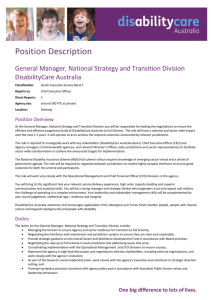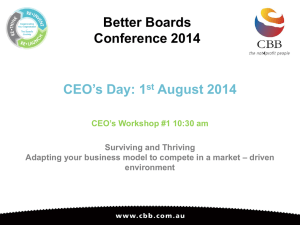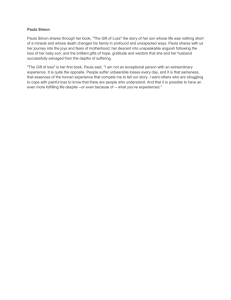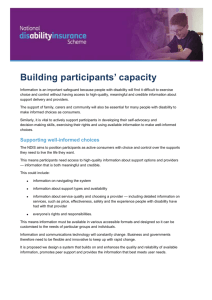Capacity Building and Self
advertisement
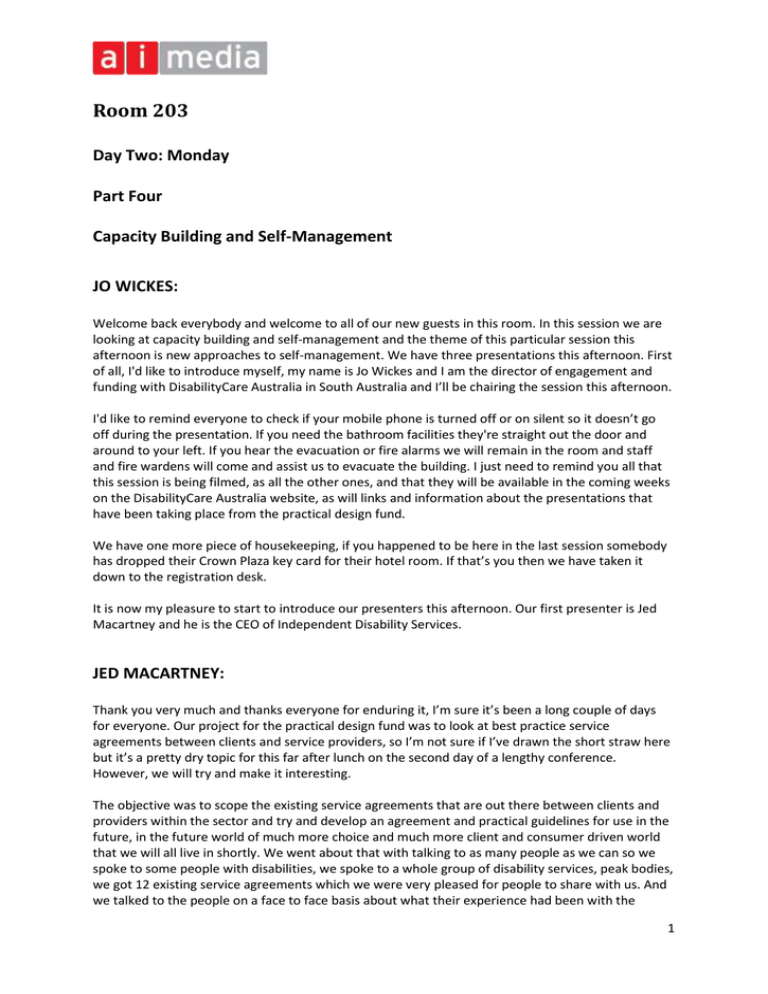
Room 203 Day Two: Monday Part Four Capacity Building and Self-Management JO WICKES: Welcome back everybody and welcome to all of our new guests in this room. In this session we are looking at capacity building and self-management and the theme of this particular session this afternoon is new approaches to self-management. We have three presentations this afternoon. First of all, I'd like to introduce myself, my name is Jo Wickes and I am the director of engagement and funding with DisabilityCare Australia in South Australia and I’ll be chairing the session this afternoon. I'd like to remind everyone to check if your mobile phone is turned off or on silent so it doesn’t go off during the presentation. If you need the bathroom facilities they're straight out the door and around to your left. If you hear the evacuation or fire alarms we will remain in the room and staff and fire wardens will come and assist us to evacuate the building. I just need to remind you all that this session is being filmed, as all the other ones, and that they will be available in the coming weeks on the DisabilityCare Australia website, as will links and information about the presentations that have been taking place from the practical design fund. We have one more piece of housekeeping, if you happened to be here in the last session somebody has dropped their Crown Plaza key card for their hotel room. If that’s you then we have taken it down to the registration desk. It is now my pleasure to start to introduce our presenters this afternoon. Our first presenter is Jed Macartney and he is the CEO of Independent Disability Services. JED MACARTNEY: Thank you very much and thanks everyone for enduring it, I’m sure it’s been a long couple of days for everyone. Our project for the practical design fund was to look at best practice service agreements between clients and service providers, so I’m not sure if I’ve drawn the short straw here but it’s a pretty dry topic for this far after lunch on the second day of a lengthy conference. However, we will try and make it interesting. The objective was to scope the existing service agreements that are out there between clients and providers within the sector and try and develop an agreement and practical guidelines for use in the future, in the future world of much more choice and much more client and consumer driven world that we will all live in shortly. We went about that with talking to as many people as we can so we spoke to some people with disabilities, we spoke to a whole group of disability services, peak bodies, we got 12 existing service agreements which we were very pleased for people to share with us. And we talked to the people on a face to face basis about what their experience had been with the 1 existing service agreements, had they had one in place, how had it worked, how was it put in place and that sort of stuff. Based on the feedback we got we put a draft service agreement and that’s what we’ve devised in the end, it’s a necessarily a legalistic type of document because it is an agreement between two entities being the individual and a service provider and so we’ve put that document together and it’s hopefully going to be up on the website for you guys to use. The majority of the participants we found didn’t use a formal agreement at the moment, most acknowledge the importance of having one although there was often a view that they were pretty friendly with the people that were either their carers or service providers and that maybe there wasn’t a need for one. And I think most of us feel that way about most contracts, you don’t need them until the trouble starts. The template we developed, we think it is really a starting point and I think the whole exercise was interesting. It wasn’t so much about what's in the agreement, although that obviously is important, but it’s more about how you go about coming to that agreement. So we’ve done an easy English version and we’ve put a checklist of what we think are the key mandatory and discretionary items in the service agreement. So if you have a look, there’s a whole pile of definitions at the front that hopefully help with the key words that are used. The agreement then goes into some responsibilities of the service provider and the individual. So all that’s the droll legal type stuff that is necessary in an agreement. Where it really kicks in though is what’s in the list of schedules. So this is where your nitty gritty ends up in the schedules and the stuff that we’ve put in the schedules we’ve got there a number of items. Some we think are mandatory and some are discretionary. So there’s things in there like that the individual’s care plan, the service provider’s complaint procedure and we see that as being mandatory. So right up front you know what that process is and how you go about it if you're not happy with the service you’re receiving. The service provider’s privacy policy, again mandatory for obvious reasons. Any other information that the client would like or that’s mandatory by law, the service provider’s rates so what you’ll be charged. Details of what you’ll get for that, so this is all about providing some clarity, creating expectations right up front about what the service will be and how much you’ll pay. So getting that stuff away from, oh I thought I was going to get this or oh no, didn’t we tell you that type of thing. Finally, we’ve put together a little quality assurance or an evaluation document that we think you can use to find out whether the clients are happy with the service agreement. It’s interesting that putting all that stuff together is fairly obvious, the thing that wasn’t as obvious was the way that most people said that we should go about putting this in place. Most people said this should be a client driven document and a client owned document which is probably in reverse to what we’ve been using up until now, typically if there’s been a service agreement it’s been something generated by the service provider probably shoved under someone’s nose and said, these are the relevant bits, look at that, sign here. So we think that this provides a template for starting the conversation, it’s not necessarily just to fill in a couple of boxes and there should be some very real conversation around those things that are in the schedules. So what did people want? They said that the agreement should be fair, so it’s a balance of rights and obligations so some of the service agreements we saw, including our own previous one, talked a lot about what was expected of the client and not so much what was expected of the service provider. It needed to avoid complex language and we have done an easy English version as well so hopefully that will help. 2 Needed to clearly articulate and identify what services will be provided and I think the more detail that goes into that the better and I think that’s the real consultation bit. That’s probably where the conversation should start, talking about what exactly do people want from the service provider and if you can get that out there then that’s going to make a much better relationship in the long term. It protects the confidential information of clients and includes a process for dispute resolution, these are fairly standard things. There’s a fair and timely process for varying and terminating the agreement and it should be reviewed at least annually in our view because people’s needs change, their desires change, they shouldn’t be bound by it. As I said, it’s got the schedules that have all that stuff in detail. So the best practice part of this is really identifying expectations of the level of service quality, the timeliness of that service delivery and methods of payment. So all that stuff should go in, the detail about this is what I expect, this is when I expect it, this is when I need help. So clearly identifies those goals and outcomes. We’re talking about innovation and new ways of doing things and I think this is the crux of it, the client should determine the selection of those discretionary items that go in the agreement. Obviously it has to be in negotiation and we would encourage that the more simple, clear language that goes in there and the more clarity around what goes into the agreement the more likely it will be that that’ll be easily used if it ever has to be. Hopefully this’d be a document that really sets up the relationship and then gets put in a draw and no one ever goes near it again because the relationship’s going well. The second bell, so that’s my time and that’s worked perfectly. Thank you, we were very grateful to the people who gave us a lot of time and their opinions to contribute. It was a privilege working with them and thanks also to DisabilityCare Australia for letting us come along today and helping us do the project. Thanks very much. JO WICKES: Thank you very much Jed. Now, I’d like to introduce Daniel Leighton and Daniel is the CEO of Inclusion Melbourne. DANIEL LEIGHTON: Thanks Jo. Welcome everyone and as Jed said I’d like to thank you all for being here, we’re in the graveyard shift and Jed and I both got some pretty dry topics to talk about. Yesterday there were two presentations in this room presented by Inclusion Melbourne and our project partners around principles of choice and supporting people with disabilities and their families to find the best support provider that met their needs. But today I’m talking about a very different topic and that’s around the costing of our support services for people with a disability and the production this little guide of which there are copies available for people at the end. So just very quickly we’re going to run through the process we use, the outputs and some of the learnings that took place and I think they’ll be instructive for providers across Australia. Excuse me, I totally lost my voice on Thursday and I’m hoping it holds out. So, everyone has a plan and we’ve been hearing lots about plans for individuals and all of the current disability support providers and those to come in the next few years will also have plans about how they want to work with people. 3 But it was Mike Tyson who once remarked that everyone had a plan before the fight until they first got punched in the mouth. Whilst DisabilityCare Australia is going to offer people with a disability increased choice and control particularly by the self-management of their support funds, we hope that it leads to new partnerships between people with disabilities and the support organisations. We want to make sure that those relationships are enduring and meaningful to all concerned. Very brief history on Inclusion Melbourne, we began as a day service in 1950 and we started our journey towards individualisation supports in 1990, slightly earlier. By 2008 we’d sold of our centre as by then all of our supports were being provided to individuals in community based settings and a key plank of our transformational work was the development of individualised budgets and developing effective costing tools. We took what was still block funding from government and we broke it down. This practical design project grew out of our experiences along that journey and we want to share some of it and we took that opportunity through the practical design fund to share some of our experiences. Just like the photo of Mike Tyson there, we too got punched in the mouth so two years of a whole lot of expensive work with consultants and we left out a really important thing, and that was brokerage and within six months people were purchasing nearly 40 percent of their supports from organisation other than our organisation which is exactly the intent of providing individualised budgets to people, we just hadn't factored that in and we realised if we didn’t do something about it we’d go broke pretty quickly. So it was back to the drawing board for us and like I said I hope this project enables us to provide some of our learnings to the wider sector. So the very first thing we did was to go to an expert in the sector and that’s Tim Flowers so a very great partner to have along for the journey. Tim’s just sitting there in the audience if you want to stand up for a second, he’s an accountant with a heart. (Laughing) Order, order. So what do we do, this is really simple. We set down to develop some training guides and draft costing models for people and they're there and you’ll see them in the packs. We brought together 15 disability support providers, those providers had revenues between one million and $15 million which really makes up the composition of disability support provider network across Australia that largely they are smaller organisations. They don’t have CFOs with years of commercial experience in order to be able to put together pricing models and so for us it was a learning about where the skill set is at. One of the things that we recognise is that if we are to have a vibrant community sector, which I’m passionate about, then we needed to make sure that the service providers are fully cognisant of the prices that they charge and need to be able to charge. So we held these workshops covering these topics and they were interactive sessions with learnings that went both ways. In terms of the products made, there’s this guide here, a dvd at the back with an Excel spreadsheet and the like for people to work through and during the course of those workshops they were refined as people identified issues related to say, awards structure and how to build them into the model. And what’s within the actual booklet, the fancy terminology I can tell you, you’ll find that it’s all written in layman’s terms. As we said, we were pitching it at the wider community sector to understand. So things like guidelines for pre-tender and engagement, due diligence and stress testing and guidelines for post-engagement measurement of package and unit costs. That’s something that you 4 might want to discuss with your accountant but not something to discuss on the dinner table and so it’s all in very easy English for people to follow. It’s not about what we produced, it’s about what we learnt. So Tim and I discussed that there were there areas where we felt that the sector as a whole needs to consider as it makes the transition to DisabilityCare Australia. First one was about working and understanding your cost drivers, you know, that services need to be more financially literate if they're going to move from block funded services into individually costed supports. The second thing was for services to be consistent and to understand what they were going to measure so that they could over time understand what those costs were. And the third thing was to understand and develop and analyse the impact of the factors such as the risk to their business, things like cost and replacement of assets, other service providers providing similar services and the like. And there are some lists of various things for people to consider in the work. So once you understand your costs, what else is going to help people understand the transition through to an individualised world? The first thing we say is effectively communicate the true costs of service delivery to the people you work with. One of the things we’ve understood as being a pioneer in explaining costs to people when no one else was doing it was that people felt that services were very expensive. Now there are other services that they can benchmark us against but there’s also obviously a relationship between cost and quality that we have a conversation with people about. The second tip that we offer to people is for everyone to identify their core competencies and don’t try and be all things to all people, and alongside that, think about people’s value propositions. So, you know, are you going to provide a base level attendant care supports or are you going to provide very niche services to individuals or a higher level of quality and support for families and for the community around the individual. We would also suggest that people start to collect outcomes based data so that you can actually back up the claims you make on the website. It’s amazing here in Victoria where I work every single provider says they're personalised but when I ask them if I can do a certain activity at a certain time with a certain worker they say no, no, no. So it’s time for people to own up to what they can and can't do. Finally, our final tip is to really know who it is that you're working with already because any for profit business will tell you that it’s a lot cheaper to retain your existing customers than to chase new business. So I’ll wrap up here and at the end of the session I’m available to anyone who wants to ask any further questions, thank you. JO WICKES: Thank you very much Daniel. Our last presentation today is going to be given to you by Peter Knight and Paula Mar and they're both from Wesley Mission. PAULA MAR: Thank you very much. As Jo said, my name is Paula Mar and this is Peter Knight and I think we’ve had a bit of an interesting journey coming to this point of the conference today. Peter’s background is of chartered accountants and feel free to take a photo of Peter as well. I think he’s got a heart and I come from a disability background and our project was around looking at a financial toolkit to 5 support people with disabilities to make choices around how they would like to manage their package. We undertook a process of consultations with families and people with disabilities within Wesley Mission particularly around families who had young children within our respite services who would probably be one of the first recipients moving forward with DisabilityCare Australia. So that was a very interesting exercise to work with families and one of the questions that we did ask the families before we started, if you rated a score out of one to ten your understanding of the NDIS how would you rate yourself. And one particular fellow came back and said, minus six, you know, we’re really concerned and scared for the future for our son. We took that as an opportunity to work with our families to engage them through a process of consultation. PETER KNIGHT: We’re going to have our PowerPoint presentation up on the screen there. PAULA MAR: Ok so we were commissioned to build a user friendly website, a mobile app and a simple financial toolkit and report on the user experience. PETER KNIGHT: That might be up to me to be pushing these buttons. PAULA MAR: So the site was designed to introduce DisabilityCare Australia in a way that provides easy user access, an overview and detailed information about DisabilityCare Australia, help to identify the funding options most suitable, infographics and diagrams for multiple learning styles, and a financial calculator to assist users to plan and allocate their funds. PETER KNIGHT: So we’ve got the website address there which is wesleymission.org.au/ndismyway and it’s active now. PAULA MAR: Ok so this is the home page of the site and it gives some really clear information about what the NDIS and from the current traditional service system into self-management or individualised funding for people with disability moving forward. 6 The first slide is how my NDIS my way website can assist users and so for a person who’s actually eligible for funded assistance, my NDIS my way website can provide information on DisabilityCare Australia and assist in identifying the funding option that best suits them and their lifestyle. PETER KNIGHT: This is the first of a few graphics that we’ve got. You’ll see this sort of feature come along where you’ve got the person or the people, funding comes direct to you and choosing a provider and that theme goes throughout a few of them. PAULA MAR: So we’ve got a navigation page and this actually starts to outline the full models. These are not exhaustive models, they were models that we looked at that may be a starting point that people could work with that they could change or adapt to suit their own needs. The first one there is around provider managed and that’s more typically what we see today and we move across into shared coordination, shared management and finally self-managed. PETER KNIGHT: So what we’ve got is a page for each of these options that comes along and once again you’ll see this graphic here where you’ve got the person and the providers are in that circle there with the coloured dots around it and they get all their services from that provider and that’s an option that people have got as to how to manage their funding. The next category here is shared coordination and the idea here is that you’ve got a main provider and they provide all of the services that you want but there are some services, and they're called individual services and you can see them in the fine print up there, that you will choose. But the contract for those will come through the main provider that you have. So look, then we move to shared management and you’ll see here that the person in the blue there has individual services that they contract with directly, that have got nothing to do with their provider, perhaps the provider knows about it perhaps they don’t but they’ve also selected a provider who comes along and perhaps provides support around payroll, all sorts of facilitation support and maybe there’s a couple of services that they also contract on that person’s behalf. But once you get to this model and there’s quite a bit of detail on the website about it, this is where you would set up some sort of personal entity that would enable you to employ people, to have a tax return, to have an ABN, pay pay as you go to tax, all those sorts of things and this model sort of reflects where there is a provider that helps you to do that. Then we go to the most independent model and you’ll see there is something missing on this one. Can anyone pick what’s missing? There’s no provider at all and this is where the person, maybe they’ve got a PhD and NBA and they really don’t need yours and my input to manage their affairs. They're quite capable of doing it and it is envisaged that given that skill set and confidence in doing it that they will be able to manage it themselves, manage their own contracts and taking on the 7 support that they need perhaps through mainstream accountants or whatever else that they want to do. So that was our four options. PAULA MAR: Ok so we thought, seeing that it’s the afternoon of the last day, we thought to make it a little interactive and we wanted to introduce those of you who have a smartphone to the mobile app that we developed. Those who have a smartphone, we’re going to break with tradition and ask to turn on your phone, and if you’d like to go to the app store and put in NDIS. It’s a free app and download it and that’s what it should look like. Yes you can. PETER KNIGHT: But you’ve got to select the iPhone option just for download but once it’s downloaded then you can do it on your iPad if you know what I mean. Yeah, maybe anyone put their hand up when they’ve done that and if they're managing to do it. PAULA MAR: No, no, someone’s got it. Oh good. PETER KNIGHT: We’d prefer someone from this side of the room if you don’t mind. If you do type NDIS just in the search part up there, I’ll do it in front of everybody that’ll scare me, that’ll really work. You got it? You should be able to find just NDIS, I think we’re the only NDIS app so that makes us at the top. And you can download it and what it’s got is just a simplified version of the website. It’s got those four graphics that we found people have really responded well to in understanding their options and you can have a look through that. So has anyone managed to get it yet? Oh that’s fantastic. Ok so you’ve got that app and so our session could go well beyond today, our seven minutes to two hours and you can have a look through that in your own time. But will we have a quick look at the financial planner? So another part of our website and I wonder if you could flick this up live on the screen if I haven’t done the right thing here in connecting my laptop. But along the top you’ll see is a series of menu options and I can see them well on my screen and you’ll see them well soon in a minute. Is that the second bell? We were just getting on a roll. But anyway, there is a financial planner on there that you can pump in your income, your expense and right down the bottom it says whether you’re under or over on your funding package and whether you need to make adjustments. We’d like to thank (Inaudible), the DisabilityCare Australia and it’s been an incredible learning experience from us and Vince the guy who gave us minus six, I think he gave us eight in the end. 8 PAULA MAR: We actually have a little brochure here and happy to take any questions for anyone after the session, thank you. JO WICKES: Can you please join me in thanking all of our panel presenters this afternoon. That ends our final session and there’s a 15 minute break for people to make their way if they wish to to the Melbourne room for the final presentation of the day which is a link with Tom Shakespeare in the UK. Thank you very much for being here. 9
